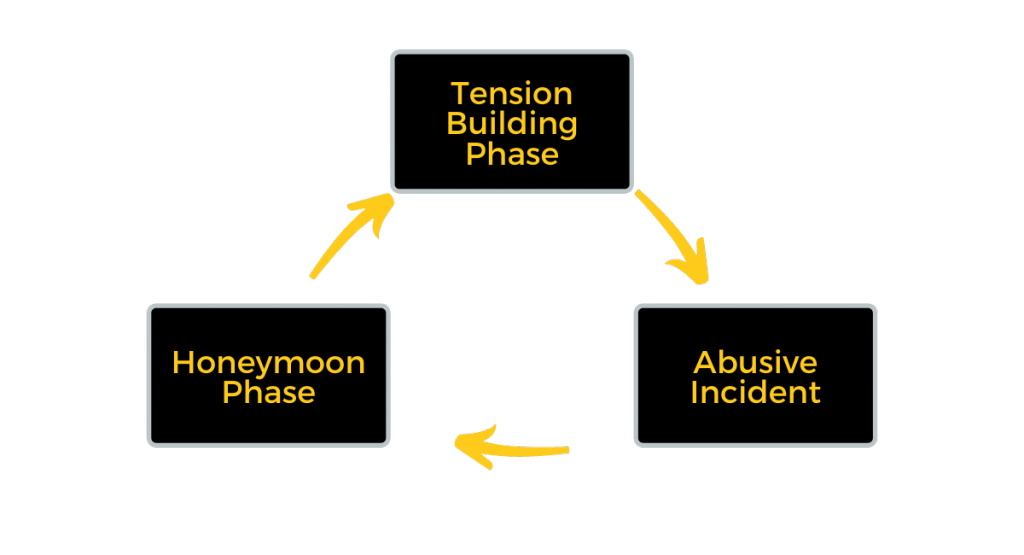Often times, survivors of domestic violence wonder or question whether they should get back together with their abuser. In this article we explain what is known as the “Cycle of Violence,” and how it may affect those contemplating the future of their relationship with an abuser.
Domestic violence is a pattern of behaviors used by one partner to maintain power and control over another partner in an intimate relationship. These types of relationships can exist between spouses, former spouses, cohabitants, boyfriend-girlfriend, domestic partners, exes, or a child’s parents. Both men and women can be victims of domestic violence.
According to the Center for Disease Control and Prevention, 1 in 4 women and 1 in 7 men have experienced severe physical violence by an intimate partner during their lifetime. Domestic violence does not discriminate against age, race, education, or sexual orientation. Teenagers who are in a dating relationship, can also fall victim to the same abuse as adults.
A REPEATING CYCLE
Domestic violence follows a repeating cycle, often referred to as “The Cycle of Violence.” Generally, the “Cycle of Violence” can be broken down into three phases:
- The tension building phase
- The abusive incident
- The honeymoon phase

TENSION BUILDING PHASE
As the name implies, the tension building phase is the phase during which tension builds in a relationship. During this time, a victim generally can feel the relationship is going wrong. This tension building phase can be as short as the time it takes for a victim and an abuser to get into an argument, to a period of days or months. During the tension building phase, a victim and abuser’s relationship becomes increasingly unhealthy. Frequently victims may feel as if they are walking on eggshells, never knowing what is going to set the abuser off. Ultimately, the tension building phase culminates in an inevitable blow-up – i.e., the abusive incident.
An abusive incident occurs when the tension between a victim and an abuser reaches a boiling point. The resulting abuse can manifest itself in several different ways, during which time the abuser lashes out at the victim. This harm can be either physical or psychological.
PHYSICAL ABUSE
The abuser may turn to physical abuse and cause corporeal harm to the victim. An abuser can also use a weapon against the victim or damage property. Physical abuse occurs when an abuser:
- Physically restrain against ones will
- Punches
- Slaps
- Hits
- Kicks
- Bites
- Strangles
- Rapes
- Pushes
- Pull Hair
- Stabs
- Burns
- Shoots
- Scratches
PSYCHOLOGICAL ABUSE
Psychological abuse can look very different and varies from abuser to abuser. Psychological abuse can be seen when an abuser:
- Insults the victim
- Name calling
- Threatens with physical harm
- Threaten to injury others like children, family members or pets
- Isolates the victim from family and friends
- Prevents the victim from seeking education or work
- Locks the victim in the home or out of the home
- Denies the victim access to basic necessities – i.e., money, phone or internet access, transportation, etc.
Many of the means by which an abuser can lash out to control a victim can be seen in the “Power and Control Wheel” below:

Abuse can initially be subtle and escalate overtime. With each repeating cycle, an abuser will tend to escalate the severity of the abuse. In some cases, this increasing escalation can result in serious bodily injury to the victim or death.
HONEYMOON PHASE
The honeymoon phase is the period following abuse, where an abuser apologizes to his or her victim regarding the abusive incident. Generally, an abuser will be extra affectionate to his or her victim to make up. This process generally includes an abuser promising his or her victim that the abuse will never happen again and that the abuser will change. These assurances by the abuser serve multiple purposes:
- To persuade the victim to stay in the relationship
- To keep the abuser out of trouble by convincing the victim to either not report the abuse to law enforcement or not cooperate with the prosecution of the case
SOME REASONS VICTIMS STAY
Many victims are convinced to stay with their abusers during the honeymoon phase. This can be due to a number of different reasons:
- Believing abuse is normal
- Love
- Shame
- Fear of retaliation
- Lack of money or resources
- Immigration status
- Fear of losing losing custody of children
- Cultural reasons
- Low self esteem and self worth
Many victims are also wrongfully convinced by their abusers or otherwise incorrectly convince themselves that the abuse was the victim’s own fault. Regardless of the victim’s reason for staying with an abuser, after a period of time, the honeymoon phase will eventually devolve back into the tension building phase. The breakdown of the honeymoon phase to the tension building phase can be almost immediate or take days, months, or years. Once the honeymoon phase ends, many of the promises made by an abuser to change will be broken. In fact, most abusers will not change, and the “Cycle of Violence” will continue until the victim decides to end the relationship.
LEARN MORE
If you are or someone you know needs help breaking the cycle of violence please visit our domestic violence page.

